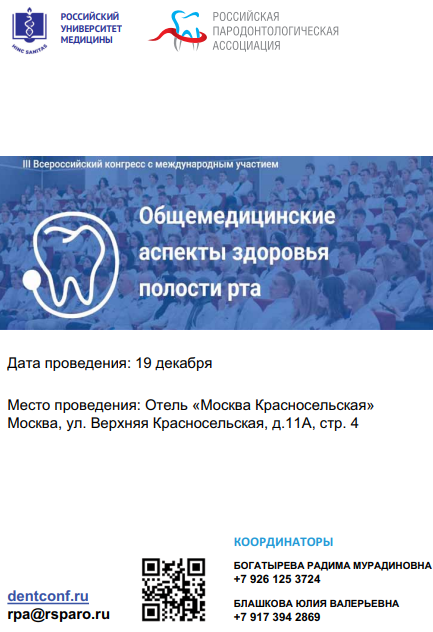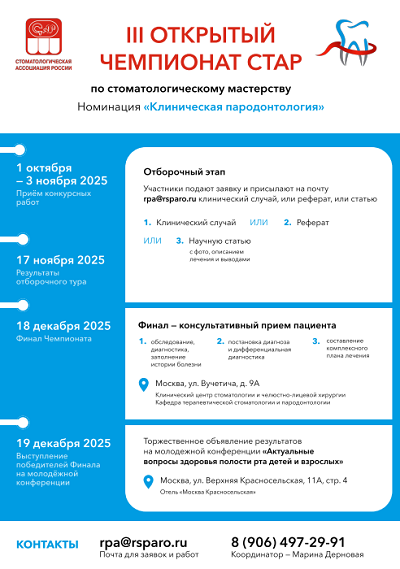Evaluation of restoration methods for primary molars based on artificial intelligence assessment
https://doi.org/10.33925/1683-3031-2025-914
Abstract
Relevance. Dental caries in primary teeth remains one of the most prevalent oral health challenges in pediatric dentistry. This is attributed to both the anatomical features of these teeth and their increased vulnerability to carious lesions. Although considerable progress has been made in dental care, the management of caries in primary teeth remains a significant clinical concern. Existing treatment methods – including various restorative techniques and materials – offer specific advantages and drawbacks, highlighting the need for continued research and refinement. Developing effective strategies is crucial not only for eliminating carious lesions but also for ensuring the long-term preservation of tooth hard tissues.
Objective. To enhance the effectiveness of treating caries and its complications in primary molars by evaluating various restoration methods using an artificial intelligence program.
Materials and methods. The study involved children aged 3 to 6 years who underwent treatment for 150 primary molars diagnosed with dentin caries (K02.1) or pulpitis (K04.0). The treated teeth were categorized into groups according to diagnosis and method of hard tissue restoration. Restoration methods included composite resin, stainless steel crowns, and zirconia crowns. Each group comprised 25 teeth. Treatment outcomes were evaluated using an artificial intelligence program that analyzed radiographic images taken immediately post-treatment and at a six-month follow-up.
Results. The artificial intelligence program showed that teeth restored with stainless steel crowns demonstrated no deviations from the evaluation criteria, regardless of the initial diagnosis (dentin caries or pulpitis). In contrast, composite restorations exhibited a high rate of deviations across various criteria for both caries and pulpitis. Zirconia crowns showed no deviations when used for pulpitis treatment.
Conclusion. According to all evaluation criteria assessed by the artificial intelligence program, stainless steel crowns are recommended for the treatment of caries and its complications in primary molars.
About the Authors
A. B. BagatirovaRussian Federation
Aishat B. Bagatyrova, DMD, Pediatric Dentist
7 Bryanskaya Str., Moscow, 121059
O. A. Gavrilova
Russian Federation
Olga A. Gavrilova, DMD, PhD, DSc, Professor, Head of the Department of Pediatric Dentistry and Orthodontics
Tver
References
1. Kuzmina EM, Yanushevich OO, Kuzmina IN, Lapatina AV. Tendency in the prevalence of dental caries among the Russian population over a 20-year period. Dental Forum. 2020;(3):2-8 (In Russ.). Available from: https://elibrary.ru/item.asp?id=43825063
2. Kosko AV. Clinical efficiency of standard metal crowns usage for temporary molar restoration in child dentistry according to three years of observation. Pediatric dentistry and dental prophylaxis. 2018;17(1):53-58 (In Russ.). Available from: https://www.detstom.ru/jour/article/view/125/
3. Malekafzali B, Ghasemi A, Torabzadeh H, Hamedani R, Tadayon N. Effect of multiple adhesive coating on microshear bond strength to primary tooth dentin. J Dent (Tehran). 2013;10(2):169-174. Available from: https://pubmed.ncbi.nlm.nih.gov/23724217/
4. Yanushevich OO, Zueva TE, Kiselnikova LP, Zolotnitsky IV, Vasileva NU, Ogareva AA. Implementation of dental preventive measures among the child population in the regions of the Russian Federation in 2021-2022. The dental institute. 2024;(2):6-8 (In Russ.). Available from: https://elibrary.ru/item.asp?id=68366232
5. Omidi BR. Microleakage of an Enhanced ResinModified Glass Ionomer Restorative Material in Primary Molars/ BR. Omidi, FF. Naeini, H. Dehghan et el. J Dent (Tehran). 2018;15(4):205-213. Available from: https://pubmed.ncbi.nlm.nih.gov/30405729/
6. Shih WY. Microleakage in different primary tooth restorations. J Chin Med Assoc. 2016;79(4):228-234. doi: 10.1016/j.jcma.2015.10.007
7. Korolenkova MV, Arzumanyan AP. Comparative study of microleakage in primary molars restored with filling and stainless-steel pediatric crowns after pulpotomy simulation in vitro. Pediatric dentistry and dental prophylaxis. 2019;19(1):46-50 (In Russ.). doi: 10.33925/1683-3031-2019-19-69-46-50
8. Chisini LA, Collares K, Cademartori MG, de Oliveira LJC, Conde MCM, Demarco FF, Correa MB. Restorations in primary teeth: a systematic review on survival and reasons for failures. Int J Peadiatr Dent. 2018;28(2):123-139. doi: 10.1111/ipd.12346
9. Korolenkova MV, Arzumanyan AP, Vasilyeva AV. Microleakage in primary molars restored with filling and stainless steel pediatric crowns: a comparative in vitro study. Pediatric dentistry and dental prophylaxis. 2018;17(2):47-50 (In Russ.). doi: 10.25636/PMP.3.2018.2.9.
10. Korolenkova MV, Arzumanyan AP. Comparative efficacy of filling materials and stainless-steel pediatric crowns for primary molars restoration. Pediatric dentistry and dental prophylaxis. 2018;18(4):41-46 (In Russ.). doi: 10.25636/PMP.3.2018.4.8
11. Seminario AL, Garcia M, Spiekerman C, Rajanbabu P, Donly KJ, Harbert P. Survival of zirconia crowns in primary maxillary incisors at 12-, 24- and 36-mounth follow-up. Pediatr Dent. 2019;41(5):385-390. Available from: https://pubmed.ncbi.nlm.nih.gov/31648670/
12. Taran PK, Kaya MS. A Comparison of Periodontal Health in Primary Molars Restored with Prefabricated Stainless Steel and Zirconia Crowns. Pediatr Dent. 2018;40(5):334-339. Available from: https://pubmed.ncbi.nlm.nih.gov/30355428/
13. Lopez Cazaux S, Hyon I, Prud'homme T, Dajean Trutaud S. Twenty-nine-month follow-up of a paediatric zirconia dental crown.BMJ Case Rep.2017;2017:bcr2017219891. doi: 10.1136/bcr-2017-219891
14. Fedotov KI, Rusanov FS, Mandra YuV, Kiselnikova LP. Analysis of adhesiveness of various filling materials on hard tissues of primary teeth. Pediatric dentistry and dental prophylaxis. 2017;16(1):16-19 (In Russ.). Available from: https://www.detstom.ru/jour/article/view/36
15. Donly KJ, Sasa I, Contreras CI, Mendez MJC.Prospective randomized clinical trial of primary molar crowns: 24-month results. Pediatr Dent. 2018;40(4):253- 258. Available from: https://pubmed.ncbi.nlm.nih.gov/30345963/
Supplementary files
Review
For citations:
Bagatirova A.B., Gavrilova O.A. Evaluation of restoration methods for primary molars based on artificial intelligence assessment. Pediatric dentistry and dental prophylaxis. 2025;25(2):171-178. (In Russ.) https://doi.org/10.33925/1683-3031-2025-914





































